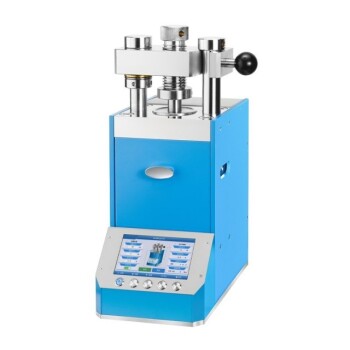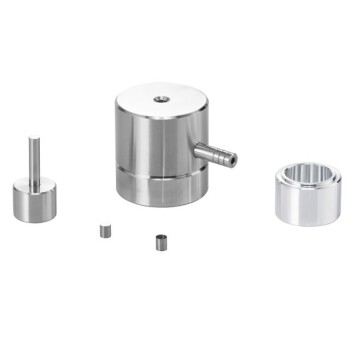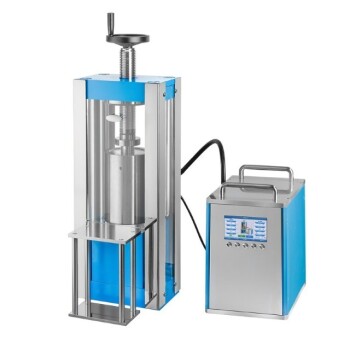At its core, a manual hydraulic press is a device that uses a hand-operated pump to generate significant compressive force. It consists of a hydraulic oil-filled cylinder, a piston that moves within it, and a pressure gauge for monitoring. These presses are commonly used in laboratory settings for tasks like preparing KBr pellets for FTIR spectroscopy or sample pellets for XRF analysis.
The central trade-off of a manual hydraulic press is its simplicity and low cost versus the physical effort and lower repeatability it demands. While it provides precise force for individual tasks, its reliance on an operator makes it less suitable for high-volume applications where consistency is paramount.
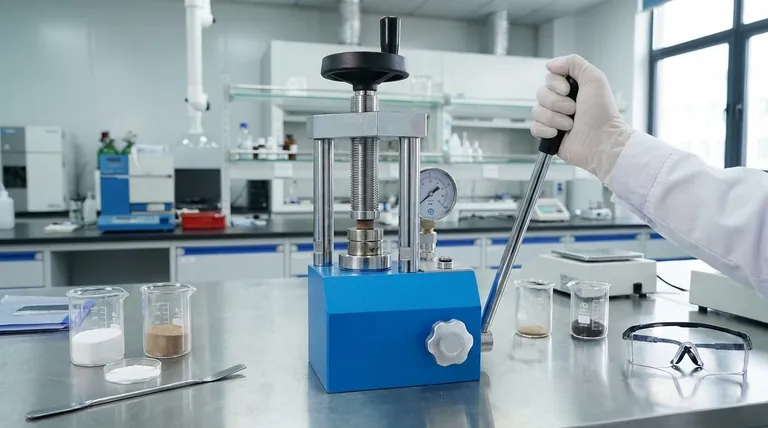
The Core Mechanism: How a Manual Press Generates Force
A manual press creates high pressure through the simple principle of hydraulic force multiplication. The operator's small effort on a lever is transformed into a large force on the sample.
The Hand-Operated Pump
The primary user interface is a hand-operated lever or pump. As the operator pumps the lever, they push hydraulic oil into the main cylinder.
This manual action directly controls the rate and amount of pressure being applied to the sample, giving the user tactile feedback.
The Hydraulic Cylinder and Piston
The system's power comes from a sealed cylinder filled with hydraulic oil and a large-diameter piston. The oil, being incompressible, transfers the pressure from the small pump to the large piston.
This multiplies the initial force significantly, allowing a user to generate loads that can reach up to 25 tons (approximately 250 kN) with manageable physical effort.
The Integrated Pressure Gauge
An accurate pressure gauge is a critical feature. It provides a clear, real-time display of the force being exerted on the sample.
This allows the operator to apply a specific, required pressure and avoid over- or under-compressing the material, which is vital for creating consistent sample pellets.
Key Operational Features
Beyond the core mechanism, several features define the utility and safety of a modern manual hydraulic press.
Variable and Controllable Force
Most manual presses offer a wide range of force, often up to a maximum load of 25 tons. This force is fully variable, controlled by the operator's action on the pump and monitored via the gauge.
Interchangeable Pressing Tools
To suit different applications, these presses accommodate interchangeable pressing tools (die sets) of various diameters, such as 15 mm, 32 mm, or 40 mm. This flexibility allows for the creation of different-sized sample pellets from powder.
Built-in Safety Mechanisms
Safety is addressed through features like an automatic pressure relief valve. This mechanism prevents damage to the unit and enhances operator safety by automatically releasing pressure if the system is stressed beyond its maximum rated load.
Understanding the Trade-offs: Manual vs. Automatic
Choosing a manual press involves weighing its distinct advantages against its inherent limitations, especially when compared to automated alternatives.
Advantage: Cost and Simplicity
The most significant benefit of a manual press is its lower initial cost and simpler design. With fewer moving parts and no complex electronics, they are also easier and less expensive to maintain.
This makes them an ideal choice for labs with limited budgets or for applications where the press will be used infrequently.
Disadvantage: Operator Effort and Fatigue
The primary drawback is the physical effort required. Applying high pressures repeatedly is labor-intensive and can lead to operator fatigue.
For high-throughput environments requiring frequent sample preparation, a manual press can quickly become a bottleneck.
Disadvantage: Consistency and Repeatability
Because pressure is applied by a human operator, achieving perfectly repeatable pressure from one sample to the next is challenging.
In contrast, an automatic press uses electronic controls to apply a pre-programmed force with high accuracy every time, eliminating operator-induced variability and ensuring more consistent results.
Making the Right Choice for Your Goal
The decision between a manual and an automatic press depends entirely on your specific operational needs, sample volume, and budget.
- If your primary focus is low-volume sample prep or academic teaching: A manual press is a cost-effective, durable, and practical tool that provides hands-on experience with the process.
- If your primary focus is high-throughput analysis or strict process control: An automatic press is the superior choice for its efficiency, unmatched repeatability, and reduction of human error.
Ultimately, selecting the right press is a matter of balancing the need for precision and throughput against the realities of your budget and workflow.
Summary Table:
| Feature | Description |
|---|---|
| Hand-Operated Pump | Allows manual control of pressure with tactile feedback for precise application. |
| Hydraulic Cylinder | Uses incompressible oil to multiply force, enabling up to 25 tons of load. |
| Pressure Gauge | Provides real-time force monitoring to ensure accurate and consistent sample compression. |
| Interchangeable Tools | Supports various die sizes (e.g., 15mm, 32mm) for flexible pellet preparation. |
| Safety Mechanisms | Includes automatic relief valves to prevent overpressure and enhance operator safety. |
| Cost and Simplicity | Lower initial cost and easy maintenance, ideal for budget-conscious or low-volume labs. |
| Operator Effort | Requires physical input, which may lead to fatigue in high-use scenarios. |
| Consistency | Less repeatable than automatic presses due to human variability in pressure application. |
Upgrade your laboratory's sample preparation with KINTEK's reliable lab press machines! Whether you need an automatic lab press for high-throughput consistency or a manual hydraulic press for cost-effective, low-volume tasks, KINTEK specializes in solutions that enhance precision, safety, and efficiency. Our products, including isostatic and heated lab presses, are designed to meet diverse laboratory needs—reducing errors and saving time. Contact us today to discuss how we can support your specific applications and boost your workflow!
Visual Guide
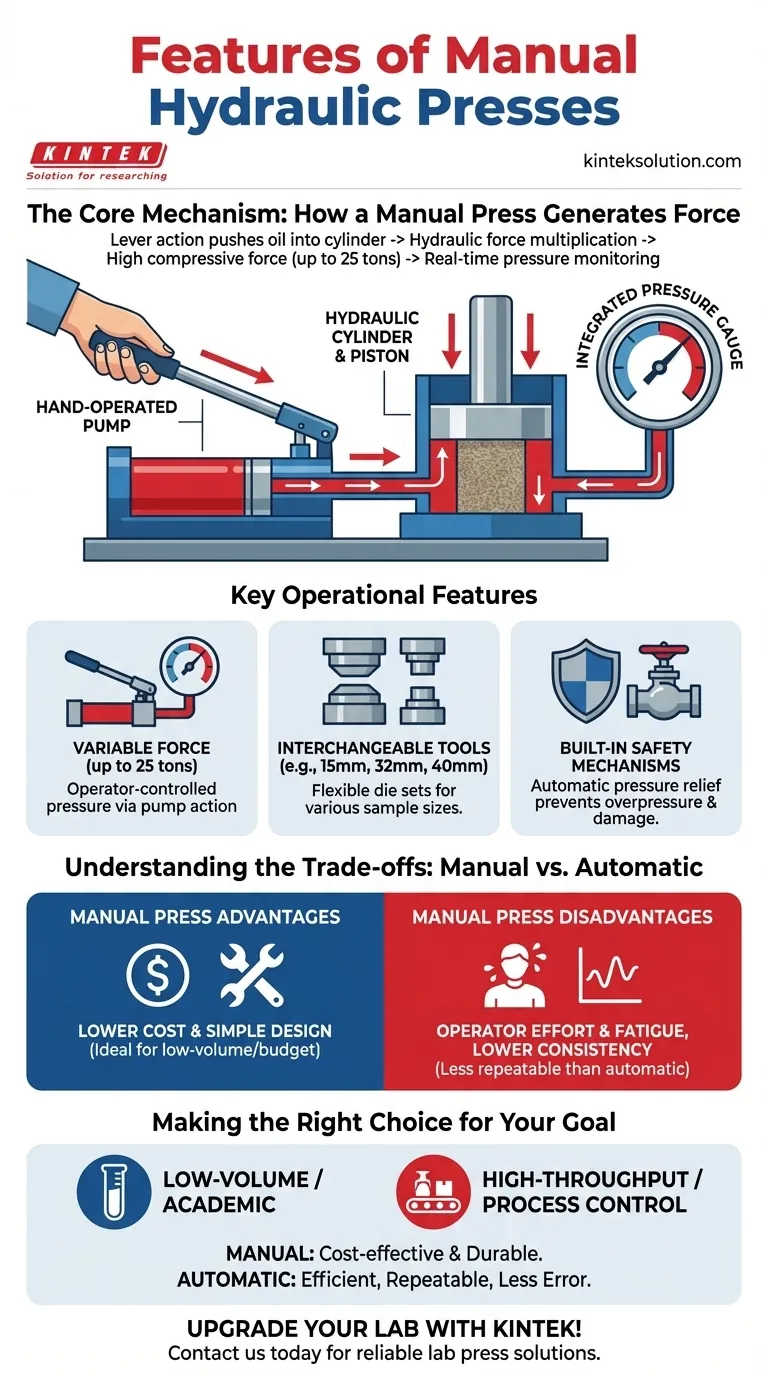
Related Products
- Manual Laboratory Hydraulic Press Lab Pellet Press
- Laboratory Hydraulic Press 2T Lab Pellet Press for KBR FTIR
- Laboratory Hydraulic Press Lab Pellet Press Button Battery Press
- Manual Heated Hydraulic Lab Press with Integrated Hot Plates Hydraulic Press Machine
- Automatic Laboratory Hydraulic Press Lab Pellet Press Machine
People Also Ask
- How should a manual hydraulic pellet press be cleaned and maintained? Ensure Accurate Results and Longevity
- What are the key features of manual hydraulic pellet presses? Discover Versatile Lab Solutions for Sample Prep
- What are the steps for assembling a manual hydraulic pellet press? Master Sample Prep for Accurate Lab Results
- What is the primary purpose of a manual lab hydraulic pellet press? Ensure Accurate Sample Prep for XRF and FTIR
- What safety features are included in manual hydraulic pellet presses? Essential Mechanisms for Operator and Equipment Protection














